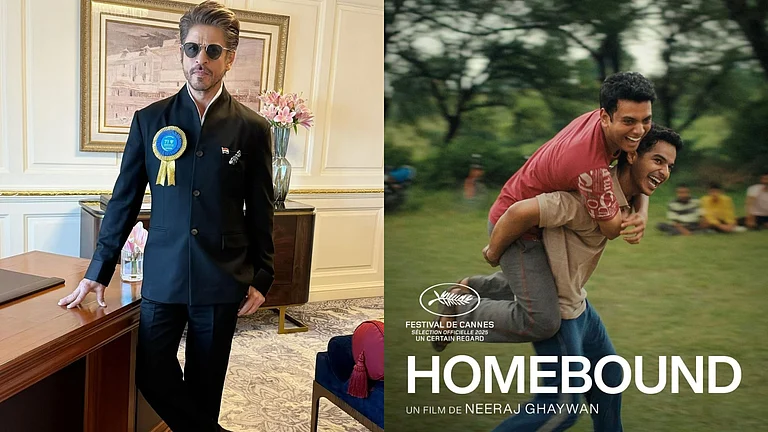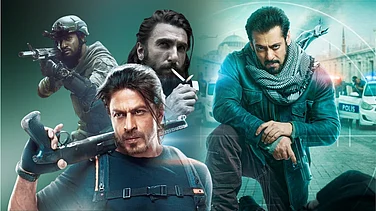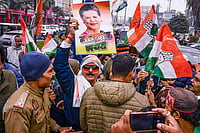
Neeraj Ghaywan's Homebound is a disruptive look into working-class lives, shorn of glitzy appendages common to Hindi cinema
Films like Gully Boy invoke poverty in soft strokes, airbrushing it within a tale of individual ambition
Dhadak 2 is another recent, rare outlier that takes on systemic oppression without gentrifying, prettifying impulses
The release of Neeraj Ghaywan’s Homebound has been greeted with critical acclaim for its “inclusive, empathetic gaze.” The film resists the dominant Bollywood trend by grounding its story in the lived realities of India’s working class—rickshaw drivers, factory laborers, domestic workers—without romanticizing or aestheticizing their struggles. Its gaze is patient, attentive, even humble, a far cry from the glossy treatment poverty typically receives in mainstream cinema today.
But Homebound is the exception, not the rule. For the past two decades, mainstream Bollywood has steadily drifted away from seeing poverty as a social condition to be reckoned with. Instead, poverty now appears as an aesthetic, Instagrammable backdrop. An artfully distressed wall behind Ranveer Singh in Gully Boy (2019) or the expressionist reds in the lower middle class milieu of Dolly Kitty Aur Woh Chamakte Sitare (2019)—these films are often ideated in the cafes of Bandra and Versova, imagined not as chronicles of systemic marginalization but as stylish parables of personal ambition.
The poor no longer exist in Hindi cinema as social actors in their own right. They exist as mood boards.
This is a remarkable shift when one considers the films of the past. The mainstream hero was often a man from the margins—a coolie, clerk, mill worker, taxi driver, or small-time hustler. His class identity wasn’t decorative; it was the narrative. Amitabh Bachchan’s iconic “angry young man” of the 1970s channeled working-class rage against a corrupt system. Rajesh Khanna and Dharmendra played schoolteachers and middle-class professionals who struggled with debt and dignity. Till as late as the nineties, Aamir Khan played the cab driver in Raja Hindustani (1996) and a loser from a poor background in Rangeela (1995)—and managed to get the girl both times.
These stories may have been melodramatic, but their protagonists were firmly rooted in India’s everyman realities. They mirrored the anxieties of a newly urbanizing society, where migration, unemployment, and inflation were everyday struggles.

There was another crucial phase—one where Indian filmmakers looked unflinchingly at the disenfranchised with political clarity and emotional precision. The 1980s parallel cinema movement—led by directors like Shyam Benegal, Saeed Mirza, and Mira Nair—offered stories that placed the working poor and the unemployed at the center of the frame, not its fringes.
In Benegal’s Ankur (1974) and Manthan (1976), the rural poor were not metaphors but people—angry, hopeful, and caught in the machinery of feudal and capitalist oppression. Saeed Mirza’s Albert Pinto Ko Gussa Kyun Aata Hai (1980) and Salim Langde Pe Mat Ro (1989) explored the urban underclass with empathy and political awareness, while Mira Nair’s Salaam Bombay (1988) captured street children’s lives with documentary-like intimacy. These films didn’t aestheticize poverty—they interrogated it. They reminded audiences that social injustice wasn’t a theme, it was a condition.
Contrast that with contemporary films, where “struggle” is more likely to mean affording a guitar or a ticket to a rap competition than wondering where the next meal will come from.
A turning point perhaps came with Slumdog Millionaire (2008) —a film not technically Bollywood, but deeply influential in reshaping cinematic tropes of poverty. The slums of Dharavi became a globally recognized “brand": vibrant, colorful, resilient. Indian filmmakers soon caught on.
In Gully Boy, Dharavi is rendered through graffiti, rap battles, and hip-hop swagger. Its authenticity is unquestionable, but its gaze is gentrified. Slum life becomes an exotic site of creativity, resilience, and grit—stripped of sewage, malnutrition, and systemic brutality. The camera lingers on hoodies, graffiti walls, and indie soundtracks more than on hunger or structural violence.

Similarly, Dolly Kitty Aur Woh Chamakte Sitare takes place in a small-town milieu of cramped flats and call centres, but its poor are mostly quirky dreamers trying to achieve consumerist goals—a cooler, a lipstick, a better apartment. Liberation is redefined as the right to consume, aligning neatly with the aspirations of Netflix-watching urban audiences.
What has disappeared almost entirely is the working class as the center of the narrative. Where once Hindi cinema revolved around mill strikes, housing shortages or rural indebtedness, today’s films avoid systemic critique.
Instead, poor characters exist to validate the lives of middle-class or upper-class protagonists. In Kapoor & Sons (2016) and Kabir Singh (2019), the domestic worker is a comic on the side. In Zindagi Na Milegi Dobara (2011), the Spanish farmer appears only to highlight the privilege of the Indian bachelors on holiday. Poverty lingers at the edges of the frame, rarely demanding attention. Scouring this year's mainstream releases, one finds the poor have conveniently vanished. Films have become versions of the gated communities their audiences reside in.
As cities gentrify and the middle class becomes Bollywood’s primary paying audience, cinema reflects their fantasies rather than their fears. The poor become safe projections, not confrontational presences.
That is what makes Homebound so striking. Unlike Gully Boy, it does not aestheticize life. Unlike Dolly Kitty, it does not equate liberation with shopping. It stays with the material conditions of its characters: the precarity of gig work, the indignity of domestic labor, the shrinking possibilities of upward mobility. Its gaze is not pitying or voyeuristic, but empathetic and structural.
Another recent outlier is Dhadak 2 which reverses the erasure of its predecessor. Where Dhadak (2018) famously stripped caste out of Sairat’s (2016) DNA, turning systemic critique into a multiplex-friendly romance, Dhadak 2 attempts a course correction. It places caste violence back at the centre of the narrative, refusing to let the love story float free of social structures. The boy’s home, with its cramped quarters, shift-working parents, and their modest but urgent aspirations for him—steady employment, a government job, stability, anchors the romance in a lived working-class reality. Brutality is not softened, and the consequences of transgressing caste hierarchies are shown in ways Hindi cinema has long avoided. The film is far from perfect. Its gloss and star presence sometimes blunt its political edge. But in confronting caste directly while situating its characters within the texture of working-class family life, it marks a rare moment when Bollywood re-engages with systemic oppression rather than prettifying it.
There are several reasons why this gentrified gaze exists. Demographics have shifted. The multiplex-going urban middle class is Bollywood’s primary revenue source. And filmmakers are writers come from this milieu too. Their anxieties are not about subsistence but about self-actualization. Cinema reflects that.
With Netflix and Amazon Prime as new distributors, films are increasingly pitched to cosmopolitan audiences, for whom slums are exotic but must remain consumable.

Neoliberal aspirations, the dreams of “making it” have replaced collective struggle as the dominant cultural motif. Characters are validated not by solidarity but by their ability to buy into consumerist lifestyles. And it goes without saying that structural critiques of poverty risk censorship, political backlash, or commercial failure. A hoodie-wearing rapper is safer than a striking mill worker.
What is lost in this gentrification of gaze is not only representation but also critique. If poverty is only an aesthetic, then inequality has no cause, no villain, and no solution beyond individual escape.
The angry young man of the 1970s was angry at something—corrupt politicians, exploitative bosses, a failing state. Today’s protagonist is angry only at parents who won’t let him buy a bike. The systemic axis of oppression vanishes, replaced by interpersonal conflict. This distortion is not trivial. Cinema is one of India’s most powerful cultural mirrors. To strip poverty of its brutality is to strip society of its conscience.
What would it mean for Bollywood to reclaim an honest gaze? Not necessarily grim social realism, but a recognition that the working class still exists—that clerks, teachers, domestic workers, and small farmers continue to shape the nation’s pulse. Films like Homebound suggest it is possible. To show poverty without voyeurism, to tell working-class stories without reducing them to décor.

Even as Bollywood continues to sanitize poverty into a backdrop, there are signs that audiences are ready for more grounded stories. The appetite for “reality” is unmistakable. Homebound itself was adapted from a reported feature in The New York Times, proof that journalistic attention to working-class lives can travel into cinema with resonance. In India, The Indian Express has launched an entire vertical to promote stories from its reporting archives as potential material for film and streaming adaptations. Publishers of nonfiction, too, now market their books explicitly for the screen, banking on the idea that true stories about labor, caste, gender, migration can cut through the noise of formulaic entertainment. This convergence of journalism, publishing, and cinema hints at the possibility of a course correction. If filmmakers and audiences are willing to look beyond Bandra Versova cafés and embrace reportage, memoir, and lived experience as their raw material, then more on-the-ground stories may bloom. And if audiences respond, as they have to Homebound, perhaps the gentrified gaze will no longer dominate Bollywood’s view of poverty.
Ultimately, the task is not simply to bring back the “angry young man.” It is to ask harder questions about why his anger existed in the first place. And why Bollywood, in its glitzy multiplex era, is so determined to forget.
Samina Motlekar is a screenwriter and former advertising film producer based in Bombay.



























